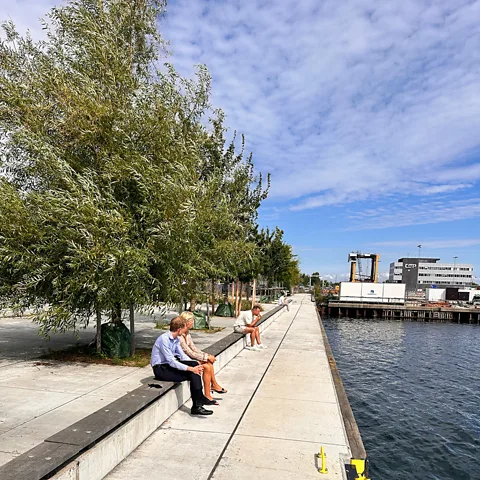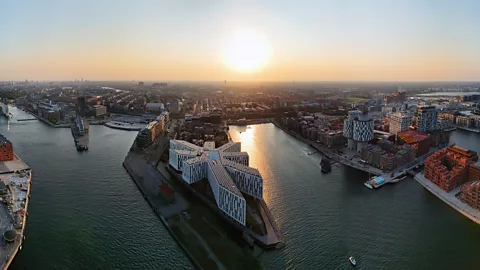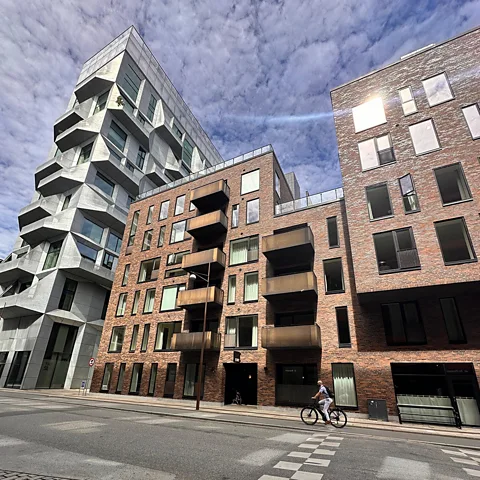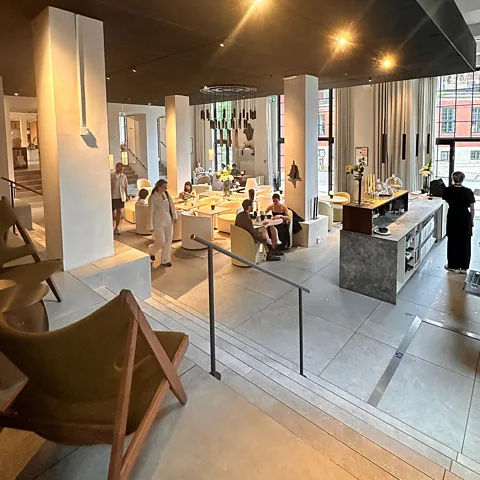Nordhavn: The Danish 'city' that's been designed for an easy life
 Getty Images
Getty ImagesCopenhagen's once-industrial port has been planned to make everything – from schools and play areas to businesses and recreational spaces – accessible within five minutes.
While cruising the canals of Copenhagen in the summer of 2023, my guide pointed out Nordhavn, the city's once-industrial neighbourhood, excitedly claiming it would become the coolest new city in Europe. From the boat, I couldn't see much beyond a few residential buildings and lots of giant construction machinery, but, as an architect, I was interested to know more.
So, 12 months later, I returned to Copenhagen and headed back to Nordhavn, just a 15-minute metro ride from Copenhagen's central station.
This time, standing at Århusgadekvarteret, the core of the new development, I could see gleaming apartment buildings, high-end office spaces and a cafe-lined boardwalk along the previously industrial harbour. Dozens of people were lying on colourful beach towels spread across the waterfront, all soaking in the Scandinavian summer sun. It was a peaceful, serene scene, with none of the morning commuter chaos I was used to seeing in cities around the world.
And that's because Nordhavn has been specifically designed to make life easier.
"Although it looks like any modern district, it's the world's first five-minute city," explained my guide, Bente Hoffman from immersive cultural tour company Slow Tours. "When the project is complete, everything you need will be within a 400m walk."
 Shalbha Sarda
Shalbha SardaCommuting is one of the biggest challenges of modern life as it adds so much time into the daily routine. Nordhavn (officially a district of Copenhagen, but described as a city due to its scale and scope) has been designed to make everything – from schools and play areas to businesses and recreational spaces – accessible within five minutes. It is setting a blueprint for a world where residents can fit in a morning workout before strolling to the office, grab lunch at a cute cafe, have a quick swim at the harbour and still make it home in time to take your kids to the playground – all before enjoying a cosy candlelit dinner at home.
Imagine doing all of this without driving from one point to another, without feeling exhausted, and being able to repeat it every day while staying carbon neutral.
"We are creating a neighbourhood that meets everyday needs and special occasions," explained Peter Bur Andersen, an architect from BRIQ Studios that played a crucial role in zoning Nordhavn. "Everything is within walking or biking distance, minimising the need for commuting. The area also promotes a mostly car-free lifestyle, connected by cycle paths and the metro."
Green Getaways
Green Getaways is a BBC Travel series that helps travellers experience a greener, cleaner approach to getting out and seeing the world.
Copenhagen is currently the Unesco World's Architecture Capital (until 2026) and innovative solutions for smart living have been brewing across the Danish capital: from Paper Island, designed to focus on public spaces and housing for all income groups; to Carlsberg City District that's built on four pillars of beer production: science, innovation, art and culture.
 Getty Images
Getty ImagesHowever, Nordhavn's five-minute city concept is unique. While there are a few 10-minute cities being developed around the world, including one in Seoul, South Korea, Nordhavn's one-of-a-kind concept is the most ambitious urban development project in Scandinavia. It is also the only new urban district anywhere in the world to receive a gold certification for sustainability from the German Sustainable Building Council, or DGNB (the largest network for sustainable building in Europe), according to Andersen.
In Nordhavn, sustainability is about more than reducing energy consumption. Every building constructed must consider its social, economic and environmental impact. For example, the Big Bio Cinema – the city's newest theatre – is constructed from recyclable materials such as aluminium in case the building ever needs to be demolished.
Top tips:
When to go: June-August for warmer weather.
What to do: Take a guided walking tour. Explore the design shops in the harbour area. Head to Konditaget Lüders, a carpark rooftop that serves as an open-air public gym. Watch a movie at Big Bio Cinema.
Where to stay: Audo House, a former warehouse transformed into a boutique hotel with a café and concept store.
Where to eat:
- Located on the 17th floor of a former grain silo, Restaurant Silo has impressive views and a seasonal menu.
- Headed by Rosio Sanchez, a former dessert chef from Noma, Hija de Sanchez Cantina is a two-minute walk from the Sandkaj Harbour.
- Palmarès Bike Café is a unique spot for cyclists, offering coffee, croissants and a bike workshop, with bike parts as décor.
And, according to Anderson, social and economic inclusion has been at the core of all planning. "It is important to bring back what worked well in history," he said. "We used to have the butcher, craftsman, baker and cheese shop – that diversity in everyday encounters. The future city should mix recreational, cultural and commercial spaces, all easily accessible within the neighbourhood."
But until relatively recently, no one would have considered living in this once-industrial district. Irshia Nasreen, an engineer born and raised in central Copenhagen, says, "While I was trying to find a new neighbourhood to move out of the city centre, I never thought I'd move here."
Bente adds, "I didn't think I would do tourist walks in Norhavn. There was nothing to see."
 Shalbha Sarda
Shalbha SardaAfter all, for centuries Nordhavn was a free port filled with cargo ships, grain silos and metal containers. The buildings that existed were warehouses and industrial shipping structures. Then, in 2008, a competition was held to create a sustainable neighbourhood for Copenhagen's future: 179 proposals were submitted and a group of four architectural firms, COBE Architects, Sleth, Rambøll and Polyform were winners.
They designed an urban area of "soft mobility", where it is easier to walk, bike or use public transport than it is to drive; and put the idea of hybrid spaces – something that "avoids creating lifeless spaces and fosters community among residents, employees and visitors", according to Andersen – at its heart. For example, in Nordhavn, a multi-storey car park might have a gym on its roof; an apartment building could include a public restaurant; and a hotel could house a concept store.
Although the entire Nordhavn project won't be finished until 2060, it is being developed in islets (small islands), with key areas such as Nordø and Århusgadekvarteret, already complete and full of life, brimming with locals and tourists. A metro extension to Nordhavn and Orientkaj opened in 2020, providing easy access from the city centre.
More like this:
• 10 sustainable travel destinations to visit in 2024
As Hoffman and I walked through Nordø, I admired the ingenuity of using once-unassuming buildings to create chic destinations. Audo House, a warehouse from 1918, is now a boutique hotel, concept store and cafe. Across the road, MENY food supermarket was once a factory for building guns. Because of the building's protected status, MENY had to use the same walls, windows and ceilings as the former World War Two gun factory to create what is now a futuristic food market. Nearby, the raw steel surface of The Silo still resembled its days as a grain silo. But it has now been transformed into a luxurious 17-storey residential building with a public restaurant.
 Shalbha Sarda
Shalbha Sarda"The beauty of Nordhavn lies in the blend of old and new architecture standing side by side," said Hoffman. "Sustainability is also about preserving the past by repurposing old buildings for modern use."
Nasreen moved to Nordhavn in 2023 and says the calm, car-free environment has transformed her lifestyle. "I love walking around here," she said. "After living in the city centre for 40 years, not hearing the hums of vehicles is refreshing. The proximity of water to all residential areas gives a sense of peace and fresh air. My nephew is awed by the fact that he can swim in the harbour, walk back home for a shower and then go back to the waterfront to enjoy coffee in a cool café. Isn't that amazing?"
Carbon emissions:
The travel emissions it took to report this story were 1.57 metric tons of CO2e. Find out more about how we calculated this figure here.
She added: "I work from home, and when I need a change of scenery, I head to The Audo House. It's a multifunctional space, so you see tourists checking in the hotel and people shopping for art and furniture while I have a coffee in its cafe on a winter afternoon."
In the early 20th Century, when legendary Danish designer Arne Jacobsen said, "Architecture is not just about creating buildings; it's about shaping the environment and enhancing people's lives," it was theoretical. A century later, Hoffman is leading curious designers and architects like me on walking tours around Nordhavn. As curious as I am, and perhaps with the same intent, they are looking for answers to the question: can architecture be one of the keys to creating a happier urban environment?
For Nasreen and many others living in Nordhavn, the answer is a resounding yes.
--
If you liked this story, sign up for The Essential List newsletter – a handpicked selection of features, videos and can't-miss news, delivered to your inbox twice a week.
